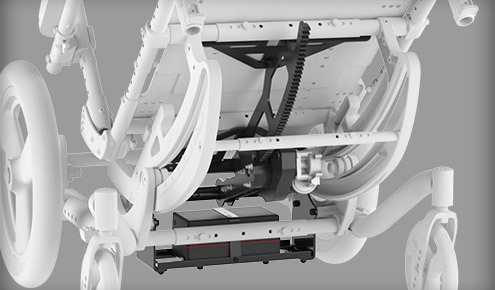-
Description
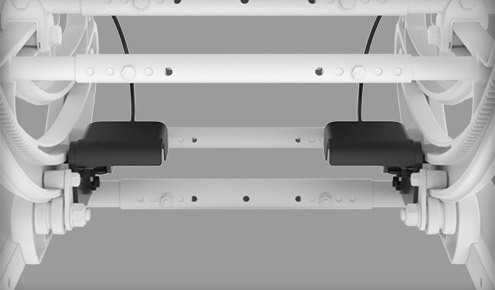 Single Tilt Mechanism Only at Ki! You requested, we Engineered. Focus CR is the ONLY adult tilt-in-space that gives caregivers the opportunity to tilt with their right or left hand for those who are multitasking.
Single Tilt Mechanism Only at Ki! You requested, we Engineered. Focus CR is the ONLY adult tilt-in-space that gives caregivers the opportunity to tilt with their right or left hand for those who are multitasking. Ease of Adjustment The Focus CR is also a smart tilt. The chair will tell you how much adjustment is needed so you have more time to focus on the other details of your day. No rotation design has ever been so easy to adjust. Ever.Only 2 bolts are required to make the CG adjustment. In most cases the adjustment can be done with the seating system and client in position.
Ease of Adjustment The Focus CR is also a smart tilt. The chair will tell you how much adjustment is needed so you have more time to focus on the other details of your day. No rotation design has ever been so easy to adjust. Ever.Only 2 bolts are required to make the CG adjustment. In most cases the adjustment can be done with the seating system and client in position. Hanger Options Because the human body doesn't grow in one inch increments you will appreciate the 70° and 80° front mount hangers. With expanded foot positioning operations, adjustments in .5" increments and extended footrest lengths you can count on achieving the positioning the client needs.Our 4-Way Hanger Release options allow you to mount the hanger release in 4 different positions with ONE bolt! The Inline position provides the best optimization for caregivers while the Out position provides the best optimization for the client.
Hanger Options Because the human body doesn't grow in one inch increments you will appreciate the 70° and 80° front mount hangers. With expanded foot positioning operations, adjustments in .5" increments and extended footrest lengths you can count on achieving the positioning the client needs.Our 4-Way Hanger Release options allow you to mount the hanger release in 4 different positions with ONE bolt! The Inline position provides the best optimization for caregivers while the Out position provides the best optimization for the client.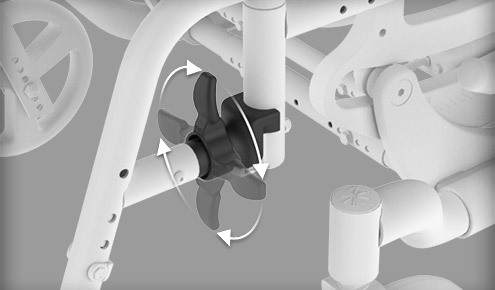 Anti-Tips Tired of bending down to constantly adjust anti-tips? Fumbling with the button locks to get them out of the way? This flip-up spring-loaded design makes it simple. Now just use your foot to easily flip them up and down as required. Need we say more?
Anti-Tips Tired of bending down to constantly adjust anti-tips? Fumbling with the button locks to get them out of the way? This flip-up spring-loaded design makes it simple. Now just use your foot to easily flip them up and down as required. Need we say more?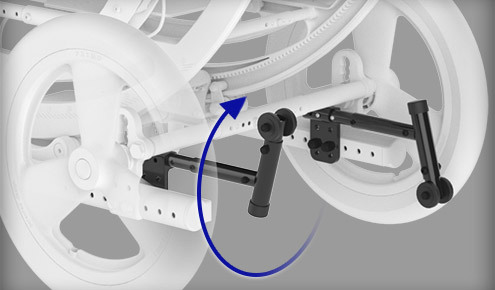 Roller Bearings Unlike other tilt-in-space wheelchairs that use plastic rollers or plastic bushings in their tilt mechanisms the Focus CR utilizes 8 precision sealed bearings of the highest quality. The ultimate in durability and virtually maintenance free, each bearing comes with a lifetime warranty at no additional charge.
Roller Bearings Unlike other tilt-in-space wheelchairs that use plastic rollers or plastic bushings in their tilt mechanisms the Focus CR utilizes 8 precision sealed bearings of the highest quality. The ultimate in durability and virtually maintenance free, each bearing comes with a lifetime warranty at no additional charge.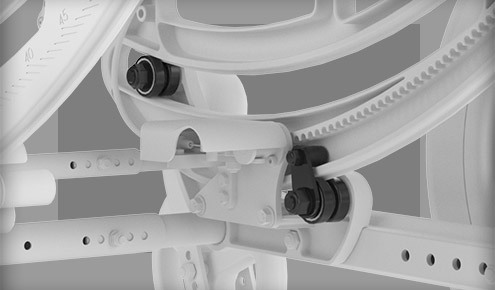 Adjustable Height Back with Fold Down Stroller Handles Compact knuckle design on the fold down stroller handle allows for a range of motion from 30° to 270°. This ensures the caretaker always has comfortable hand positioning no matter the angle of tilt the chair is in. It also enables the handles to be folded down flush tight against the back canes so the chair can be transported in tight spaces much easier.
Adjustable Height Back with Fold Down Stroller Handles Compact knuckle design on the fold down stroller handle allows for a range of motion from 30° to 270°. This ensures the caretaker always has comfortable hand positioning no matter the angle of tilt the chair is in. It also enables the handles to be folded down flush tight against the back canes so the chair can be transported in tight spaces much easier.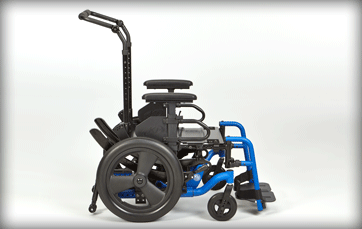 Make it Right, Now Included!Both the Focus CR and Focus CRe, now come with the assurance of our Make It Right program!
Make it Right, Now Included!Both the Focus CR and Focus CRe, now come with the assurance of our Make It Right program! OPTIONS
OPTIONS SPECIFICATIONS
SPECIFICATIONSTransport Weight 33 lbs (15 kg) Seat Width 14" - 24" (35.6 - 61 cm) Seat Depth 14" - 22" (35.6 - 55.9 cm) Seat Height 13" - 20.5" (33 - 52.1 cm) Top Frame Tubing Size 1" (2.54 cm) Weight Capacity 300 lbs (136.1 kg) Weight Capacity HD 400 lbs (181.4 kg) Tilt Range -5° - 50° Transit Approved YES *16”x16” with Stroller Handle Back Posts, 6”x1” Poly Casters. Armrests, Footrests and Rear Wheels Removed.COLORSGloss (Frames and Accents) Gloss Black
Gloss Black Champagne
Champagne Ruby Red**
Ruby Red** Deep
Deep
Sapphire Blue** Yellow
Yellow Opalescent Violet
Opalescent Violet Dark Pink
Dark Pink Glacier Blue
Glacier Blue Electric Green
Electric Green Radiant Orange
Radiant Orange Purple Plum
Purple Plum Blue Steel
Blue Steel Light Pink
Light Pink Rich TealMatte (Frames and Accents)
Rich TealMatte (Frames and Accents) Shadow Black
Shadow Black Tactical Green
Tactical Green Dry Earth Tan
Dry Earth Tan White
White Bright Red
Bright Red Platinum**
Platinum** Iridescent Navy
Iridescent Navy -
Size Chart / measuring guide
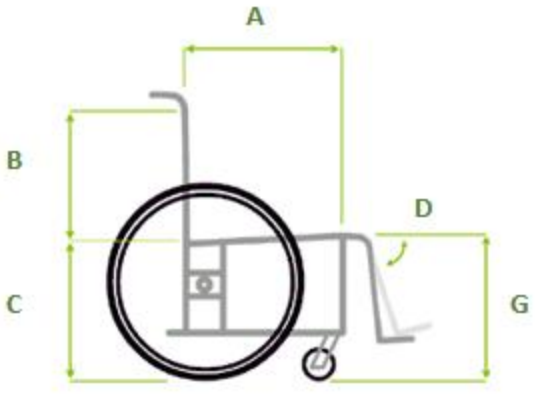
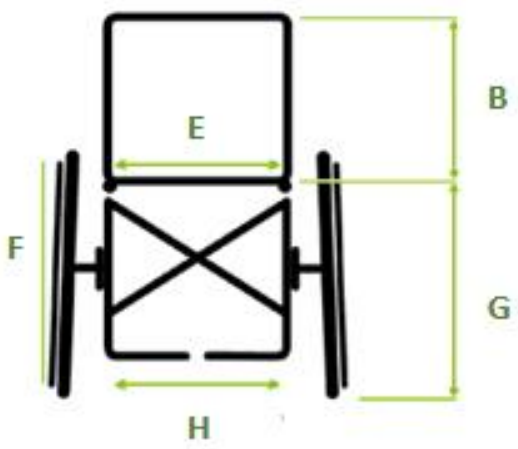
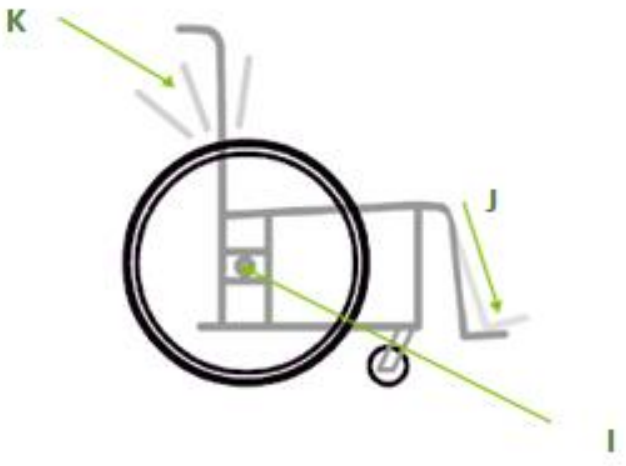 A-Seat DepthMeasure from the most posterior point of the body to the inside of the knee, minus at least two inches. Some prefer more leg overhang to make room for their hand when lifting their leg.B-Back HeightMeasured from the seat base to the top of the wheelchair back. Depends on how much upper back support is needed, and also affects freedom for the upper body to rotate.c-Rear Seat to FloorMeasurement from the ground to the rear seat edge. Relative to the front seat-to-floor dimension, this determines the rearward slope ("dump" or "squeeze") of the wheelchair seat.D-Hanger AngleDetermines how far the toes extend away from the body, measured from the horizontal. A tighter angle allows the wheelchair to turn around in less space. Depends in part on ability of the knee to bend towards the perpendicularE-Seat WidthDetermined by the widest point of the body from knee to hip, plus an inch to ensure room to move. Consider bulk of clothing, particularly a heavy winter coat, if relevant.F-Wheel CamberAngle of the wheel relative to the vertical. More camber improves stability and agility, but also limits ability to pass through narrow spaces. A typical daily wheelchair uses three degrees of camber.G-Front Seat to FloorMeasure the leg from the back of the knee to the sole of the foot. Then subtract the thickness of the cushion when it is compressed. Next, add a minimum of two inches for footrest clearance. Do not add the footrest clearance if the wheelchair will be foot-propelled.H-Footrest WidthMeasure from the inside of each leg rest tubing the distance or desired distance between leg rests.H-Footrest WidthMeasure from the inside of each leg rest tubing the distance or desired distance between leg rests.I-Center of GravityMeasure from the front of the seat back post to the center of the rear axle.J-Seat to Footrest LengthMeasure from the edge of the seat upholstery to the top rear of the footrest.K-Backrest AngleMeasure the angle of the back post to the floor. Ninety degrees will be perpendicular to the floor, to approximate the angle from the back post to the seat, subtract two degrees from measurement for every .5" of dump
A-Seat DepthMeasure from the most posterior point of the body to the inside of the knee, minus at least two inches. Some prefer more leg overhang to make room for their hand when lifting their leg.B-Back HeightMeasured from the seat base to the top of the wheelchair back. Depends on how much upper back support is needed, and also affects freedom for the upper body to rotate.c-Rear Seat to FloorMeasurement from the ground to the rear seat edge. Relative to the front seat-to-floor dimension, this determines the rearward slope ("dump" or "squeeze") of the wheelchair seat.D-Hanger AngleDetermines how far the toes extend away from the body, measured from the horizontal. A tighter angle allows the wheelchair to turn around in less space. Depends in part on ability of the knee to bend towards the perpendicularE-Seat WidthDetermined by the widest point of the body from knee to hip, plus an inch to ensure room to move. Consider bulk of clothing, particularly a heavy winter coat, if relevant.F-Wheel CamberAngle of the wheel relative to the vertical. More camber improves stability and agility, but also limits ability to pass through narrow spaces. A typical daily wheelchair uses three degrees of camber.G-Front Seat to FloorMeasure the leg from the back of the knee to the sole of the foot. Then subtract the thickness of the cushion when it is compressed. Next, add a minimum of two inches for footrest clearance. Do not add the footrest clearance if the wheelchair will be foot-propelled.H-Footrest WidthMeasure from the inside of each leg rest tubing the distance or desired distance between leg rests.H-Footrest WidthMeasure from the inside of each leg rest tubing the distance or desired distance between leg rests.I-Center of GravityMeasure from the front of the seat back post to the center of the rear axle.J-Seat to Footrest LengthMeasure from the edge of the seat upholstery to the top rear of the footrest.K-Backrest AngleMeasure the angle of the back post to the floor. Ninety degrees will be perpendicular to the floor, to approximate the angle from the back post to the seat, subtract two degrees from measurement for every .5" of dump - Videos
-
Warranty Information
Warranty
- Ki Mobility warrants the frame and quick-release axles of this wheelchair against defects in materials and workmanship for the life of the original purchaser. All other Ki Mobility-made parts and components of this wheelchair are warranted against defects in materials and workmanship for one year from the date of first consumer purchase.
The expected life of the frame is five years.
- Home
- Manual Wheelchairs
- Tilt in Space Wheelchairs
- Ki Mobility Focus
Write a Review
×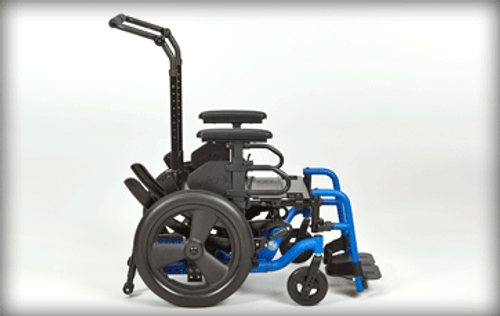
Ki Mobility
Ki Mobility Focus
Ki Mobility Focus
Ki Mobility
Ki Mobility Focus
Ki Mobility





You have accessed the BuildMyWheelchair.com website to request a consult with an Assistive Technology Professional (“ATP”) to perform a seating consult for your custom mobility needs. This consult will be conducted using Microsoft Teams with an ATP at a date and time that is convenient for you.
The ATP’s role is to assist you in ascertaining the type of wheelchair or mobility related equipment that may best fit your needs depending on your physician’s recommendations and the resources that may be available to you. Based on your input, the ATP will issue recommendations, but this consultation is not a representation or guarantee that the end product is exactly what you require or that it will meet all your needs. More importantly, Build My Wheelchair, LLC does not manufacture the specific parts or components that make up the wheelchair and, as such, we do not make any express or implied representations or warranties regarding the ultimate end product. If you subsequently have concerns about the functionality of your wheelchair or other mobility related products, Build My Wheelchair, LLC will review with you anything that is related to the assembly of your wheelchair, but we are not responsible for any specific product or component failures or malfunctions.
Please contact us at Contact@BuildMyWheelchair.com for questions regarding our services, the ATP consultation and other related items.










